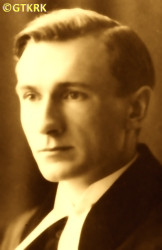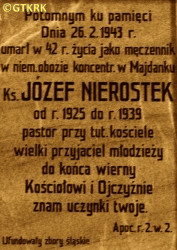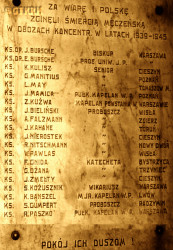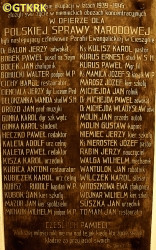Roman Catholic
St Sigismund parish
05-507 Słomczyn
85 Wiślana Str.
Konstancin deanery
Warsaw archdiocese, Poland
full list:
displayClick to display full list

searchClick to search full list by categories
wyświetlKliknij by wyświetlić pełną listę po polsku

szukajKliknij by przeszukać listę wg kategorii po polsku

Martyrology of the clergy — Poland
XX century (1914 – 1989)
personal data
surname
NIEROSTEK
forename(s)
Joseph (pl. Józef)
function
pastor
creed
Evangelical Church of the Augsburg Confession in Poland EA
diocese / province
Cieszyn seniority (commissariat) / diocesemore on
en.wikipedia.org
[access: 2016.04.23]
honorary titles
Gold „Cross of Merit”more on
en.wikipedia.org
[access: 2019.04.16]
(23.09.1938)
date and place
of death
26.02.1943

KL Lublinconcentration camp
today: Majdanek‐Lublin, Lublin city pov., Lublin voiv., Poland
more on
en.wikipedia.org
[access: 2022.01.09]
alt. dates and places
of death
19.01.1943
details of death
In 1919 as a scout fought with 10th „Cieszyn County” Infantry Regiment against Czechs in war for Cieszyn Silesia (defending Skoczów–Szumbark line).
Next took part in Polish–Ukrainian war of 1919, prob. in Gołogory battle protecting Lviv.
Prob. took also part in Polish–Russian war of 1919‐1921.
After German and Russian invasion of Poland in 09.1939 and start of the World War II, after start of German occupation, arrested in 09.1939 by the Germans.
Released after a month in prison and military barracks in Cieszyn (according to other source in Trzyniec).
Forbidden to practice as a priest by the Germans.
Forced to move in 1940 to Germ. Generalgouvernement (Eng. General Governorate): initially to Włoszczowa where worked in a hospital and then to Kielce where was an office worker in „Społem” co‐op.
There helped to organize support the families of Poles arrested by the Germans and sent to concentration camps.
There betrayed and arrested again on 20.11.1942 by the Germans (according to some sources arrested because of collaboration with resistance Home Army AK, part of Polish Clandestine State).
Held in Kielce prison.
Interrogated and tortured.
Finally in 01.1943 transported to KL Majdanek concentration camp where perished.
cause of death
extermination
perpetrators
Germans
sites and events
KL Lublin (Majdanek)Click to display the description, KielceClick to display the description, GeneralgouvernementClick to display the description, CieszynClick to display the description, Regierungsbezirk KattowitzClick to display the description, «Intelligenzaktion Schlesien»Click to display the description, «Intelligenzaktion»Click to display the description, Ribbentrop‐MolotovClick to display the description, Polish‐Russian war of 1919‐1921Click to display the description, Polish‐Ukrainian war of 1918‐1919Click to display the description
date and place
of birth
14.05.1901

Prostřední SucháTrans‐Olza
today: part of Havířov, Havířov r. mun., Karviná dist., Moravian‐Silesian reg., Czechia
more on
en.wikipedia.org
[access: 2022.02.15]
alt. dates and places
of birth
16.05.1901
Cieszyntoday: Cieszyn gm., Cieszyn pov., Silesia voiv., Poland
more on
en.wikipedia.org
[access: 2021.12.18]
presbyter (holy orders)
ordination
18.10.1925

positions held
1926 – 1939
deputy parish priest — Cieszyntoday: Cieszyn gm., Cieszyn pov., Silesia voiv., Poland
more on
en.wikipedia.org
[access: 2021.12.18] ⋄ EA parish — or: auxiliary pastor; also: chaplain of the lokac troop of Polish Scouting Association ZHP, caretaker of Care Institutes in Dzięgielów (c. 6 km from Cieszyn), editor and publisher (1936‐1939 and 1932‐1933) and the founder (1932) of „Evangelical Youth Voice” monthly, editor of „Evangelical Envoy” weekly (1932), publicist, co‐author and publisher of „History of the Evangelical Church”, social activist in Cieszyn Silesia
1927 – 1939
membership — Polish Evangelical Youth Society in the Republic of Poland — i.a. president of the Main Board (1936‐1939), vice–president of the Main Board (1934‐1936), president of the local organization in Ustroń (1927‐1936), organizer of the organization in Ustroń (07.1927)
1930
administrator — Goleszówtoday: Goleszów gm., Cieszyn pov., Silesia voiv., Poland
more on
en.wikipedia.org
[access: 2023.03.24] ⋄ EA parish — acting („ad interim”)
1926
vicar — Cieszyntoday: Cieszyn gm., Cieszyn pov., Silesia voiv., Poland
more on
en.wikipedia.org
[access: 2021.12.18] ⋄ EA parish
1925 – 1926
apprentice — TřinecTrans‐Olza
today: Frýdek‐Místek dist., Moravian‐Silesian reg., Czechia
more on
en.wikipedia.org
[access: 2022.02.15] ⋄ EA parish
1921 – 1925
student — Warsawtoday: Warsaw city pov., Masovia voiv., Poland
more on
en.wikipedia.org
[access: 2021.10.09] ⋄ Evangelical Theology Department, University of Warsaw [i.e. University of Warsaw (from 1945) / clandestine University (1939‐1945) / Joseph Piłsudski University (1935‐1939) / University of Warsaw (1915‐1935) / Imperial University of Warsaw (1870‐1915)]
1921
student — Krakówtoday: Kraków city pov., Lesser Poland voiv., Poland
more on
en.wikipedia.org
[access: 2021.06.07] ⋄ agriculture, Jagiellonian University UJ — for a month
others related
in death
BANSZELClick to display biography Charles, BIELIŃSKIClick to display biography Joseph, BURSCHEClick to display biography Edmund, BURSCHEClick to display biography Julius, FALZMANNClick to display biography Alexander Charles, FREYDEClick to display biography Alfred, GNIDAClick to display biography Francis, GUMPERTClick to display biography Steven Edward, GUTKNECHTClick to display biography Bruno, GUTSCHClick to display biography Sigismund, HAUSEClick to display biography Paul Henry, KAHANEClick to display biography George, KOŻUSZNIKClick to display biography Stanislav, KULISZClick to display biography Charles, KUŹWAClick to display biography Sigismund, LEHMANNClick to display biography George, MAYClick to display biography Leo Witold, MAMICAClick to display biography Joseph, MANITIUSClick to display biography Gustav, NITSCHMANNClick to display biography Adam Robert, OŻANAClick to display biography Gustav, PASZKOClick to display biography Richard, PAWLASClick to display biography Vladislav, WAGNERClick to display biography Richard Ernest, ZMEŁTYClick to display biography Adolph
sites and events
descriptions
KL Lublin (Majdanek): Operational in 1941‐1944, in Majdanek village n. Lublin, German Germ. Konzentrationslager (Eng. concentration camp) KL and „death” camp. Prisoners were not only local, from Lublin region, but from all over pre‐war Poland and from abroad. Most of them were Jewish, but also member of Polish clandestine resistance (part of Polish Clandestine State), Polish intelligentsia, Russian POWs, inhabitants of Zamość area evicted by the Germans, people captured in round‐ups in Polish towns and cities. 6% of the prisoners were children 14 years old and younger. Prisoners slaved at c. 16 sub‐camps working for German companies, such as Deutsche Ausrüstungswerke (DAW). Altogether c. 150,000 people were held in the camp. C. 79,000 victims were murdered, among them c. 59,000 Jews. The camp was equipped with 5 gas chambers, where prisoners were mass murdered, using gas from bottles or from capsules of Zyklon B. (more on: www.majdanek.euClick to attempt to display webpage
[access: 2012.11.23], en.wikipedia.orgClick to attempt to display webpage
[access: 2013.08.10])
Kielce: The prison at Zamkowa Str. in Kielce was opened in 1826‐1828. In 09.1939, after start of German occupation, under German control. Initially a POW camp and next prison run by German political police Gestapo. Till 1945 more then c. 16,000 prisoners were held there. Any time c. 2,000 were incarcerated, in space build for c. 400 people. Prisoners, in extremely cramped conditions, were starved, ill‐treated and murdered in prison, executed outside, transported to German concentration camps or deported to slave labour sites. Prison chapel Germans used as torture chamber. At the same time in 08.1941 (after German attack on 22.06.1941 of their erstwhile ally, Russians, do till the autumn of 1944 in Fijałkowski’s barracks in Kielce Bukówka district Germans set up a POW camp for Russian prisoners (branch of Stalag XII C „Kamienna” in Skarżysko‐Kamienna, later of Stalag 367 Częstochowa). According to one of the witnesses first 100 POWs were brought in 09.1941. A week later 4,500 more arrived and within a fortnight another 5,000. Following that the POWs were brought in groups of 500‐1,000. Altogether c. 15,000‐20,000 Russian POWs were held in the camp. POWs slaved at forest clearances, digging sewage ditches, at train loading. They got a hunger rations (as a result acts of cannibalism took place). Slept in unheated barracks. Were beaten and tortured (with wooden battons). Received to medical help. For any type of transgression they were penalized with execution. The camp was managed by the Germans and was supported by a camp’s militia, composed mainly by the Ukrainians. Only few hundred prisoners survived who in the autumn of 1944 were transferred to other camps. From 1945 in Russian Commie‐Nazi hands. Till 1956 many political prisoners, e.g. members of former restistance Home Army AK and National Armed Forces NSZ (part of Polish Clandestine State) where held camptive there. On 04‐05.1945 Polish partisans commanded by Mjr Anthony Heda attacked the prison and release c. 700 prisoners. (more on: www.chroniclesofterror.plClick to attempt to display webpage
[access: 2020.02.08])
Generalgouvernement: After the Polish defeat in the 09.1939 campaign, which was the result of the Ribbentrop‐Molotov Pact and constituted the first stage of World War II, and the beginning of German occupation in part of Poland (in the other, eastern part of Poland, the Russian occupation began), the Germans divided the occupied Polish territory into five main regions. In two of them new German provinces were created, two other were incorporated into other provinces. However, the fifth part was treated separately, and in a political sense it was supposed to recreate the German idea from 1915 (during World War I, after the defeat of the Russians in the Battle of Gorlice in 05.1915) of creating a Polish enclave within Germany. Illegal in the sense of international law, i.e. Hague Convention, and public law, managed by the Germans according to separate laws — especially established for the Polish Germ. Untermenschen (Eng. subhumans) — till the Russian offensive in 1945 it constituted part of the Germ. Großdeutschland (Eng. Greater Germany). Till 31.07.1940 formally called Germ. Generalgouvernement für die besetzten polnischen Gebiete (Eng. General Government for the occupied Polish lands) — later simply Germ. Generalgouvernement (Eng. General Governorate), as in the years 1915‐1918. From 07.1941, i.e. after the German attack on 22.06.1941 against the erstwhile ally, the Russians, it also included the Galicia district, i.e. the Polish pre‐war south‐eastern voivodeships. A special criminal law was enacted and applied to Poles and Jews, allowing for the arbitrary administration of the death penalty regardless of the age of the „perpetrator”, and sanctioning the use of collective responsibility. After the end of the military conflict of the World War UU, the government of the Germ. Generalgouvernement was recognized as a criminal organization, and its leader, governor Hans Frank, guilty of war crimes and crimes against humanity and executed. (more on: en.wikipedia.orgClick to attempt to display webpage
[access: 2024.12.13])
Cieszyn: Remand jail run by German political police Gestapo — in the southern part (today: Czech) of town — and investigative prison — in northern (Polish) side, on the other bank of Olza river — run by Germans. In 1940 the prisoners were initially held in Cieszyn jail but next, due to an overcrowding, taken to former Josef and Jacob Kohn furniture manufacturing plant, by Frydecka Str. and Jabłonkowa Str. junction on the southern bank of Olza, where a transit camp was set up. The prisoners — more than 1,000 Poles went through the camp — were interrogated and whipped with horsewhips, prior to being sent to German concentration camps. (more on: www.sw.gov.plClick to attempt to display webpage
[access: 2013.08.10])
Regierungsbezirk Kattowitz: After the Polish defeat in the 09.1939 campaign, which was the result of the Ribbentrop‐Molotov Pact and constituted the first stage of World War II, and the beginning of German occupation in part of Poland (in the other, eastern part of Poland, the Russian occupation began), the Germans divided the occupied Polish territory into five main regions (and a few smaller). The largest one was transformed into Germ. Generalgouvernement (Eng. General Governorate), intended exclusively for Poles and Jews and constituting part of the so‐called Germ. Großdeutschland (Eng. Greater Germany). From two separate new provinces were created. The two remaining were incorporated into existing German provinces. One of those was Polish Upper Silesia, which on 08.09.1939, by decree of the German leader Adolf Hitler (formally came into force on 26.10.1939), was incorporated into Germany as the Germ. Regierungsbezirk Kattowitz (Eng. Katowice Regency) and became part of the Germ. Provinz Schlesien (Eng. Province of Silesia) based in Wrocław. On 01.04.1940, the Germ. Regierungsbezirk Kattowitz was enlarged by several pre‐war German counties, and on 18.01.1941, a new German province was created, the Germ. Provinz Oberschlesien (Eng. Province of Upper Silesia), which, apart from the Germ. Regierungsbezirk Kattowitz, also included the Opole region. From 26.10.1939, when the regency was established, the law of the German state was in force there, the same as in Berlin. The main axis of the policy of the new regency, the territory of which the Germans recognized as the Germ. „Ursprünglich Deutsche” (Eng. „natively German”), despite the fact only 6% of its pre–war Polish part were Germans, was Germ. „Entpolonisierung” (Eng. „Depolonisation”), i.e. forced Germanization. The main mechanism was the introduction of the Germ. Deutsche Volksliste DVL, a German nationality list that was supposed to specify the national affiliation of the inhabitants of the region. The largest group marked in the compulsory registrations was Group 3, people who identified themselves as „Silesians” (in 1943 about 41%), and people remaining outside the DVL (about 36%). The latter group was intended to be deported to the Germ. Generalgouvernement (which did not happen en masse because German industry needed slave labor). Group 3, considered by the Germans as capable of Germanization, was subject to certain legal restrictions, and was subject to, among others, to conscription into the German Wehrmacht army. Children could only learn in German. A policy of terror was pursued against the Polish population. There was a special police court, controlled by the Germ. Geheime Staatspolizei (Eng. Secret State Police), i.e. the Gestapo, before which c. 4,000‐5,000 people were detained. For the years 1942‐1945 over 2,000 of them were verified, of which 1,890 were sentenced to death, including 286 in public executions. Thousands of people were murdered during the so‐called «Intelligenzaktion Schlesien», including 300‐650 Polish teachers and c. 61 Polish Catholic priests. The regency hosted a German concentration and extermination camp KL Auschwitz, where the Germans imprisoned c. 1,100,000 Jews (murdering c.1,000,000, i.e. c. 90% of them) and c. 140,000 Poles (murdering c. 70,000, i.e. c. 50% of them). After the end of hostilities of World War II, the overseer of this province, the Germ. Reichsstatthalter (Eng. Reich Governor) and the Germ. Gauleiter (Eng. district head) of the German National Socialist Party, Fritz Brecht, committed suicide. (more on: en.wikipedia.orgClick to attempt to display webpage
[access: 2024.06.24])
«Intelligenzaktion Schlesien»: A planned action of arrests and extermination of Polish Upper Silesia intellectual elite in general recorded in of the so‐called Germ. Sonderfahndungsliste (Eng. Special Wanted List), i.e. a proscription list of names of „enemies of the Reich” — participants of Upper Silesia uprisings, former Polish plebiscite activists, journalists, politicians, intellectuals, civil servants, priests — organised by Germans mainly in 04‐05.1940, aiming at total Germanisation of the region. The relevant decree, no IV‐D2‐480/40, was issued by the RSHA, i.e. Germ. Reichssicherheitshauptamt (Eng. Reich Security Office), and signed by Heinrich Himmler or Reinhard Heydrich. Some of those arrested were murdered in mass executions, some were deported to the German‐run Germ. Generalgouvernement (Eng. General Governorate), and some were sent to concentration camps. The personal details of 3,047 people deported within two months of 1940 were established. Among the victims were 33 Catholic priests, 22 of whom perished in concentration camps (the clergy were sent — in 5 transports — first to KL Dachau, and then to KL Gusen, where they slaved in quarries). Altogether, the Germans murdered c. 2,000 members of the Polish Upper Silesia intellectual elite. (more on: pl.wikipedia.orgClick to attempt to display webpage
[access: 2016.05.30])
«Intelligenzaktion»: German: «Intelligenzaktion» (English: „Intelligence Action”) — a German program of extermination of the Polish elite, mainly the intelligentsia and leadership layers, carried out from the beginning of the occupation in w 09.1939 to 04.1940, mainly in territories directly annexed to Germany, but also in the so‐called Germ. Generalgouvernement (Eng. General Governorate), where it was called «AB‐aktion». In the first phase, immediately after the beginning of the German occupation, during military operations carried out by the Germ. Wehrmacht (Eng. Armed Forces) and the genocidal units of the Germ. Einsatzgruppen (Eng. Operational Groups) of the Germ. Sicherheitspolizei (Eng. Security Police), i.e. SiPo, and Germ. Sicherheitsdienst des Reichsführers SS (Eng. Security Service of the Reichsführer SS), i.e. SD, organized by the Germ. Reichssicherheitshauptamt (Eng. Reich Main Security Office), i.e. RSHA, which followed the troops, carried out under the Germ. Unternehmen „Tannenberg” (Eng. Operation „Tannenberg”) — based on the so‐called Germ. Sonderfahndungsliste (Eng. Special Wanted Lists), i.e. proscription lists of Poles considered particularly dangerous to the Third Reich, prepared by the Zentralstelle II/P (Polen) unit of the German RSHA. Later, implemented by the German civilian occupation authorities and the genocidal unit of the Germ. Volksdeutscher Selbstschutz (Eng. Ethnic Germans Self‐Defense), whose members were Germ. Volksdeutsche (Eng. Ethnic Germans), i.e. representatives of the German minority in Poland. According to various sources, these lists, at the beginning of 09.1939, could have contained the details of 61,000—88,000 „dangerous” Poles — although these figures cannot be confirmed. In total, during this genocide, c. 50,000 teachers, Catholic priests, representatives of the landed gentry, freelancers, social and political activists, and retired military personnel were systematically and methodically murdered. Another 50,000 were sent to concentration camps, where only a negligible percentage survived. (more on: en.wikipedia.orgClick to attempt to display webpage
[access: 2014.10.04])
Ribbentrop‐Molotov: Genocidal Russian‐German alliance pact between Russian leader Joseph Stalin and German leader Adolf Hitler signed on 23.08.1939 in Moscow by respective foreign ministers, Mr. Vyacheslav Molotov for Russia and Joachim von Ribbentrop for Germany. The pact sanctioned and was the direct cause of joint Russian and German invasion of Poland and the outbreak of the World War II in 09.1939. In a political sense, the pact was an attempt to restore the status quo ante before 1914, with one exception, namely the „commercial” exchange of the so‐called „Kingdom of Poland”, which in 1914 was part of the Russian Empire, fore Eastern Galicia (today's western Ukraine), in 1914 belonging to the Austro‐Hungarian Empire. Galicia, including Lviv, was to be taken over by the Russians, the „Kingdom of Poland” — under the name of the General Governorate — Germany. The resultant „war was one of the greatest calamities and dramas of humanity in history, for two atheistic and anti‐Christian ideologies — national and international socialism — rejected God and His fifth Decalogue commandment: Thou shall not kill!” (Abp Stanislav Gądecki, 01.09.2019). The decisions taken — backed up by the betrayal of the formal allies of Poland, France and Germany, which on 12.09.1939, at a joint conference in Abbeville, decided not to provide aid to attacked Poland and not to take military action against Germany (a clear breach of treaty obligations with Poland) — were on 28.09.1939 slightly altered and made more precise when a treaty on „German‐Russian boundaries and friendship” was agreed by the same murderous signatories. One of its findings was establishment of spheres of influence in Central and Eastern Europe and in consequence IV partition of Poland. In one of its secret annexes agreed, that: „the Signatories will not tolerate on its respective territories any Polish propaganda that affects the territory of the other Side. On their respective territories they will suppress all such propaganda and inform each other of the measures taken to accomplish it”. The agreements resulted in a series of meeting between two genocidal organization representing both sides — German Gestapo and Russian NKVD when coordination of efforts to exterminate Polish intelligentsia and Polish leading classes (in Germany called «Intelligenzaktion», in Russia took the form of Katyń massacres) where discussed. Resulted in deaths of hundreds of thousands of Polish intelligentsia, including thousands of priests presented here, and tens of millions of ordinary people,. The results of this Russian‐German pact lasted till 1989 and are still in evidence even today. (more on: en.wikipedia.orgClick to attempt to display webpage
[access: 2015.09.30])
Polish‐Russian war of 1919‐1921: War for independence of Poland and its borders. Poland regained independence in 1918 but had to fight for its borders with former imperial powers, in particular Russia. Russia planned to incite Bolshevik‐like revolutions in the Western Europe and thus invaded Poland. Russian invaders were defeated in 08.1920 in a battle called Warsaw battle („Vistula river miracle”, one of the 10 most important battles in history, according to some historians). Thanks to this victory Poland recaptured part of the lands lost during partitions of Poland in XVIII century, and Europe was saved from the genocidal Communism. (more on: en.wikipedia.orgClick to attempt to display webpage
[access: 2014.12.20])
Polish‐Ukrainian war of 1918‐1919: One of the wars for borders of the newly reborn Poland. At the end of 1918 on the former Austro‐Hungarian empire’s territory, based on the Ukrainian military units of the former Austro‐Hungarian army, Ukrainians waged war against Poland. In particular attempted to create foundation of an independent state and attacked Lviv. Thanks to heroic stance of Lviv inhabitants, in particular young generation of Poles — called since then Lviv eaglets — the city was recaptured by Poles and for a number of months successfully defended against furious Ukrainian attacks. In 1919 Poland — its newly created army — pushed Ukrainian forces far to the east and south, regaining control over its territory. (more on: en.wikipedia.orgClick to attempt to display webpage
[access: 2017.05.20])
sources
personal:
www.luteranie.plClick to attempt to display webpage
[access: 2012.11.23], gazetacodzienna.plClick to attempt to display webpage
[access: 2013.08.17], www.straty.plClick to attempt to display webpage
[access: 2015.04.18], www.kronika.beskidzka.plClick to attempt to display webpage
[access: 2012.11.23], www.historia.us.edu.plClick to attempt to display webpage
[access: 2019.04.16], www.ptew.org.plClick to attempt to display webpage
[access: 2019.04.16]
original images:
www.bsip.miastorybnik.plClick to attempt to display webpage
[access: 2017.11.07], commons.wikimedia.orgClick to attempt to display webpage
[access: 2019.04.16], www.miejscapamiecinarodowej.plClick to attempt to display webpage
[access: 2013.12.04], www.miejscapamiecinarodowej.plClick to attempt to display webpage
[access: 2014.10.31]
LETTER to CUSTODIAN/ADMINISTRATOR
If you have an Email client on your communicator/computer — such as Mozilla Thunderbird, Windows Mail or Microsoft Outlook, described at WikipediaPatrz:
en.wikipedia.org, among others — try the link below, please:
LETTER to CUSTODIAN/ADMINISTRATORClick and try to call your own Email client
If however you do not run such a client or the above link is not active please send an email to the Custodian/Administrator using your account — in your customary email/correspondence engine — at the following address:

giving the following as the subject:
MARTYROLOGY: NIEROSTEK Joseph
To return to the biography press below:
 Click to return to biography
Click to return to biography











